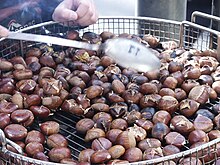Roasted chestnut
 | |
| Alternative names | Castanhas assadas, chǎolìzi, gunbam |
|---|---|
| Place of origin | Various |
| Main ingredients | Chestnuts |
| Similar dishes | Roasted sweet potato |
| Regional names | |||||||||||||||
|---|---|---|---|---|---|---|---|---|---|---|---|---|---|---|---|
| Chinese name | |||||||||||||||
| Chinese | 炒栗子 | ||||||||||||||
| Literal meaning | "stir-fried chestnut" | ||||||||||||||
| |||||||||||||||
| Korean name | |||||||||||||||
| Hangul | 군밤 | ||||||||||||||
| Literal meaning | "roasted chestnut" | ||||||||||||||
| |||||||||||||||
| Portuguese name | |||||||||||||||
| Portuguese | castanhas assadas | ||||||||||||||
Roasted chestnut is a popular autumn and winter street food in East Asia, Europe, and New York City. Asian chestnuts (Castanea crenata, C. mollissima) as well as European chestnuts (C. sativa) can be used.
Asia[]
China[]
In China, chǎolìzi (炒栗子; "stir-fried chestnut") is a popular autumn street food. Because they are roasted with sand and sweet syrup,[1] they are also called tángchǎolìzi (��炒栗子; "sugar stir-fried chestnut").
Korea[]
Gunbam (군밤; "roasted chestnut") is a popular street food in both North and South Korea.[2][3] The food is sold from late autumn to winter by the vendors wearing ushanka, which is sometimes referred to as "roasted chestnut vendor hat" or "roasted sweet potato vendor hat". A popular folk song called Gunbam taryeong (군밤타령; "ballad of roasted chestnuts") was composed by in 1932,[4] and has been sung since, being one of the songs commonly taught in public schools in South Korea.[5]
Europe and New York City[]
Portugal and Spain[]
Roasted chestnuts are popular street food in Portugal. Called castanhas assadas ("roasted chestnuts") in Portuguese, it is sold around November, when Dia de São Martinho (St. Martin's Day) is celebrated across the country.[6] Traditionally, newly harvested chestnuts are eaten around a bonfire on this day.
In some cities of Spain, during the winter period, portable grills are prepared with the intention of selling the roasted chestnuts in street stalls. In this case, the chestnuts are sold in paper cones (generally made from newspaper sheets). The tradition of the Magosto (roast chestnuts) is a tradition in the Iberian Peninsula.
New York City[]
Roasted chestnuts are sold as street food primarily in Manhattan. Though they've been sold regularly for well over a century, the major consumers are primarily tourists, not residents. Once common, they've become less so.[7] They're sold ($3-$4 a bag) starting either at the beginning of autumn, or when the first chill sets in – about the end of September, or early October, until early spring. The few vendors who currently sell them say they mostly sell to tourists around the Christmas holidays.
Gallery[]

gunbam in Korea

castagnata in Italy

castanhas assadas in Portugal
roasted chestnut vendor in China

roasted chestnut vendor in Portugal

roasted chestnut vendor in Turkey
See also[]
References[]
- ^ Xu, Wenwen (2017-01-12). "Street food centers draw city's hungry student". Shanghai Daily. Retrieved 2017-02-10.
- ^ Carruth, David (2016-11-28). "10 Korean Winter Street Foods To Bear The Cold For". 10 Magazine. Retrieved 2017-02-09.
- ^ "North Korea food shortage worst in years, despite farms". USA Today. Associated Press. 2011-07-26. Retrieved 2017-02-09.
- ^ Cho, Yoo Mi (2010). "Reconsidering on the Development of 'Gunbam Taryeong'" 경기민요 '군밤타령'의 방생 시기에 대한 재검토. Music and Culture. Korean Society for Worldmusic. 23: 109–130 – via .
- ^ 교과서 속 우리음악: 민요 '군밤타령' (in Korean). National Gugak Center. 21 June 2016. Retrieved 12 March 2017 – via YouTube.
- ^ Bratley, Carrie-Marie (2010-11-13). "Chestnuts worth their weight in gold". The Portugal News. Retrieved 2017-02-09.
- ^ Bultman, Matthew; Siemaszko, Corky (December 7, 2010). "Chestnut tradition is toast! Few N.Y.C. vendors offer treat". New York Daily News.
- Chestnut dishes
- Portuguese cuisine
- Street food in China
- Street food in South Korea
- Street food in Turkey
- Chinese cuisine stubs
- Food stubs
- Korean cuisine stubs
- European cuisine stubs
- Portugal stubs







